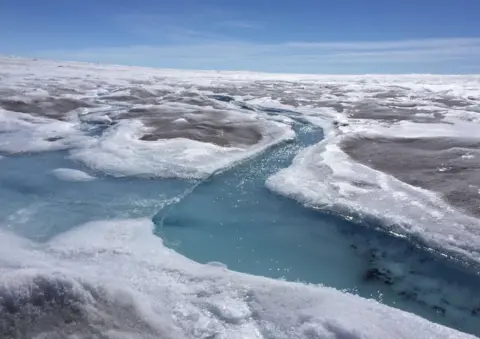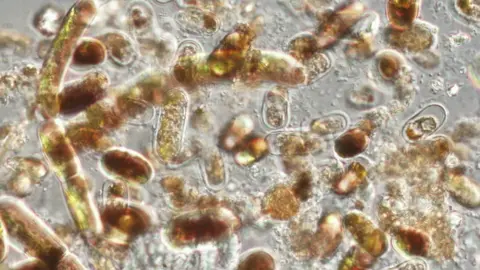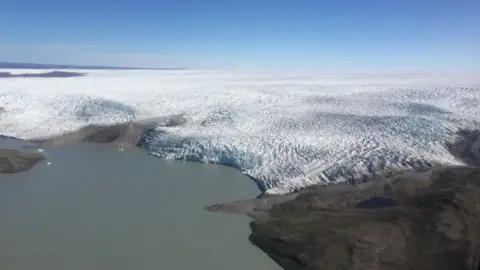Sea level fears as Greenland darkens
 Kate Stephens
Kate StephensScientists are "very worried" that the melting of the Greenland ice sheet could accelerate and raise sea levels more than expected.
They say warmer conditions are encouraging algae to grow and darken the surface.
Dark ice absorbs more solar radiation than clean white ice so warms up and melts more rapidly.
Currently the Greenland ice sheet is adding up to 1mm a year to the rise in the global average level of the oceans.
It is the largest mass of ice in the northern hemisphere covering an area about seven times the size of the United Kingdom and reaching up to 3km (2 miles) in thickness.
This means that the average sea level would rise around the world by about seven metres, more than 20ft, if it all melted.
That is why Greenland, though remote, is a focus of research which has direct relevance to major coastal cities as far apart as Miami, London and Shanghai and low-lying areas in Bangladesh and parts of Britain.
Algae were first observed on the Greenland ice sheet more than a century ago but until recently its potential impact was ignored. Only in the last few years have researchers started to explore how the microscopically small plants could affect future melting.
A five-year UK research project known as Black and Bloom is under way to investigate the different species of algae and how they might spread, and then to use this knowledge to improve computer projections of future sea level rise.
The possibility of biologically inspired melting was not included in the estimates for sea level rise published by the UN's climate panel, the IPCC, in its latest report in 2013.
That study said the worst-case scenario was a rise of 98cm by the end of the century.
One concern now is that rising temperatures will allow algae to flourish not only on the slopes of the narrow margins of the ice-sheet but also on the flat areas in the far larger interior where melting could happen on a much bigger scale.
We joined the latest phase of research in which scientists set up camp on the ice-sheet to gather accurate measurements of the "albedo" or the amount of solar radiation reflected by the surface.
White snow reflects up to 90% of solar radiation while dark patches of algae will only reflect about 35% or even as little as 1% in the blackest spots.
When we flew by helicopter onto the ice sheet, the rolling landscape seemed surprisingly grey - my first impression was that it looked dirty.
 Marian Yallop
Marian YallopMuch of the surface was covered with what looked like patches of soot and it was pockmarked with countless holes at the bottom of which were pitch-black layers of a mix of algae, bacteria and minerals known as cryoconite.
Prof Martyn Tranter of Bristol University, who is leading the project, told me:
"People are very worried about the possibility that the ice sheet might be melting faster and faster in the future.
"We suspect that in a warming climate these dark algae will grow over larger and larger parts of the Greenland ice sheet and it might well be that they will cause more melting and an acceleration of sea level rise.
"Our project is trying to understand just how much melting might occur."
Over the last 20 years, Greenland has been losing more ice than it gains through snowfall in winter - a change in a natural balance that normally keeps the ice-sheet stable.
 Kate Stephens
Kate StephensAnd one of the project scientists, Dr Andrew Tedstone, a glaciologist and also of Bristol University, said that over much of the same period, images from the MODIS satellite showed a darkening trend with the years of greatest dark producing most meltwater.
He said: "We still don't think we've reached a point where we've seen the maximum darkness that we're going to see in this area so the fieldwork we're doing is to try to find out in a warming climate 'do we think the area is going to get any darker than we've already seen in the last 15 years?'"
Earlier research had found that the ice sheet is covered with a range of contaminants carried on the winds including dust and soot from as far away as Canadian prairie fires and the industrial heartlands of China, America and Europe.
But studies over the past five years have shown that the majority of the dark material may be biological with different kinds of algae turning the ice black, brown, green and even mauve.
"This is a living landscape," according to Dr Joe Cook, a glacial microbiologist at Sheffield University.
"This is an extremely difficult place for anything to live but, as we look around us, all this darkness we can see on the ice surface is living - algae, microbes, living and reproducing in the ice sheet and changing its colour."
 Kate Stephens
Kate Stephens"We know they're very widespread and we know that they're very dark and we know that that's accelerating melt but that's not something that's built into any of our climate projections - and that's something that needs to change."
The final phase of the Black and Bloom project involves weaving the new factor of biological darkening into climate models to come up with revised estimates for future sea level rise.
And, as Dr Cook explained, the retreat of the Greenland ice sheet does not need to be total to have a widespread and damaging impact.
"When we say the ice sheet is melting faster, no one saying it's all going to melt in next decade or the next 100 years or even the next 1,000 years but it doesn't all have to melt for more people to be in danger - only a small amount has to melt to threaten millions in coastal communities around world."
Meanwhile, another factor that may be driving the melting has been identified by an Austrian member of the team, Stefan Hofer, a PhD student at Bristol.
In a paper recently published in Science Advances, he analysed satellite imagery and found that over the past 20 years there has been a 15% decrease in cloud cover over Greenland in the summer months.
"It was definitely a 'wow' moment," he told me.
Although temperature is an obvious driver of melting, the paper estimated that two-thirds of additional melting, above the long-term average, was attributable to clearer skies.
What is not known is how this might affect the algae. Their darker pigments are believed to be a protection from ultra violet light - so more sunshine might encourage that process of darkening or prove to be damaging to them.
The Black and Bloom project, funded by the Natural Environment Research Council (Nerc), aims to publish its new projections for sea level rise in two years' time.
Follow David on Twitter. and Join him for a live Facebook chat at 15:30 with Arctic explorer Pen Hadow ahead of his mission to sail to the North Pole.
